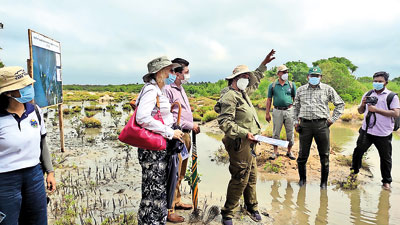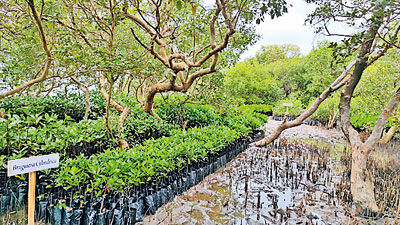News
Unique mangrove restoration project takes root in Puttalam
Sri Lanka and Britain are together supporting a unique mangrove “caretaker” programme in the Puttalam District which aims to regenerate these vital plants in a manner that will “set an example to the world”.
The project, led by Professor Sewwandi Jayakody, senior lecturer at the Wayamba University, eschews the traditional mangrove restoration approach of merely planting new trees. It focuses on returning the ecosystem of a particular area to what it was. The site is at Pubudugama in Puttalam where, last week, Environment Ministry Secretary Anil Jasinghe and British High Commissioner to Sri Lanka Sarah Hulton launched the initiative.

The site at Pubudugama: Setting an example to the world by focusing on returning the ecosystem of the area to what it was
Prof Jayakody’s team first looked at the nearest mangrove patch to analyze what contributed to its health and sustenance. This includes soil and water conditions, tidal fluctuations, inundation periods, and other factors. Many sites have saline soil because they were dug ponds that had previously been shrimp or salt farms. And the main soil component was sand as the absence of low plants such as grasses had caused sediments to blow out. This did not favour mangrove growth.
The Department of Forest Conservation trained their forest officers from Puttalam to Trincomalee on, among other things, maintaining mangrove nurseries. The replanting, meanwhile, mimicked the natural process.
Of the planted seeds, the weaker ones died while the stronger ones remained. Depending on elevation, the team cut an extensive canal system (wide and shallow) to facilitate the arrival again of lagoon water. It brought in vital sediments that settled in the soil and washed away the extreme acidity.
Soil samples were carbon tested. And once the site was completely ready, planting began. Approximately 490,000 plants were initially planted, Prof Jayakody recalled. Rhizophora Mucronata was placed along the canals because they naturally grew on shores. Avicennia Marina was planted further in, as was Ceriops Tagal.
“We expected mortality,” the Prof said. “And our target was a ten-percent survival rate since these sites had no habitation for over ten years.”
The canals also allowed animals to enter into the ecosystem, an important way to maintain and provide nutrition to the sites as well as acting as a water quality indicator. With the area now becoming more self-sufficient, the authorities are more laidback, choosing to clean the canals periodically to excess sand and waste. The plants will be left to evolve.
 The local community was drawn in. Nadeesha Sheehan, Kaveeshan Kumar, Prabasara Madushanka, and Janitha Nuwan, all 17-year-old classmates, spent hours planting seedlings. The young volunteers pitched in after beat forest officer, Sampath de Silva, scouted local schools to recruit young people. They spent around eight hours per day for a week each month attending to the nursery and mangrove plants. While they did receive a stipend, it was love for the work that motivated them.
The local community was drawn in. Nadeesha Sheehan, Kaveeshan Kumar, Prabasara Madushanka, and Janitha Nuwan, all 17-year-old classmates, spent hours planting seedlings. The young volunteers pitched in after beat forest officer, Sampath de Silva, scouted local schools to recruit young people. They spent around eight hours per day for a week each month attending to the nursery and mangrove plants. While they did receive a stipend, it was love for the work that motivated them.
Fishing and tourism are staples in the area. But authorities are also exploring other income-generating avenues for local communities. For instance, mangroves, which have small flowers, were ideal for bee-honey farming, said Conservator of Forests Nishantha Edirisinghe. The Department provided six bee colonies but only two survived owing to a lack of expertise among bee-keepers. The programme is likely to be restarted with better training.
These efforts are all the more significant as Sri Lanka has pledged to be a champion in mangrove restoration. The Foreign Ministry and Ministry of Environment championed the Mangrove Ecosystems and Livelihoods Action Group of the Commonwealth Blue Charter since 2018. It is signed by all 54 Commonwealth nations to actively co-operate to solve ocean-related problems and meet commitments for sustainable ocean development.
Through two resolutions related to mangroves proposed jointly with Indonesia at the United Nations Environmental Agency, Sri Lanka was also tasked with being an example to the world. The country is home to 21 true mangrove species, almost one-third of the global diversity of true mangroves. Approximately 18,000 hectares of mangrove forests were gazetted under the Forest Ordinance as conservation forests and reserved forests in the years 2019 and 2020.
The mangrove caretaker program underpins the work the UK and Sri Lanka are delivering on nature-based solutions in the lead up to COP26 later this year and illustrates how countries can work together to achieve shared climate and environmental objectives, a British High Commission spokesperson said.
| Replanting begins at Anawilundawa The replanting of mangrove in the ravaged Anawilundawa site will start today, World Wetland Day, said Manjula Amararathna, Director of Protected Area Management at the Wildlife Conservation Department. Site studies and preparation were in collaboration with the Wildlife and Forest Ministry, Wayamba University, and other private organizations like the Wildlife and Nature Protection Society. Prior to its declaration as a Ramsar wetland, approximately one hundred acres held shrimp farms which are now abandoned for nearly two decades. The area dried up as there was no saline irrigation. It was mostly grasslands when the Department took over the replantation project. One main canal with two smaller canals were built to water a 10-acre plot selected for the pilot project. This has improved the water levels in the soil. Checks on the salinity and PH levels of the soil, mangrove species, and the animals in the area have been completed. Various mangrove species will be planted in different locations of the plot based on these assessments. They will be monitored for three to five years, Mr. Amararathna said. The Wildlife Conservation Department will use funds from the Wildlife Preservation Fund as well as other private entities. It has been a month since the irrigation system was set up and endemic and migratory aquatic birds have begun to settle in the area. Unlike other WCD jurisdictions, the Anawilundawa area has sufficient resources in its local office including technically trained officers to monitor the project. The Anawilundawa Sanctuary was the subject of much controversy a few months ago when a local politician attempted to start up an illegal shrimp farm. However, these efforts were quelled and the involved parties heavily fined. | |


